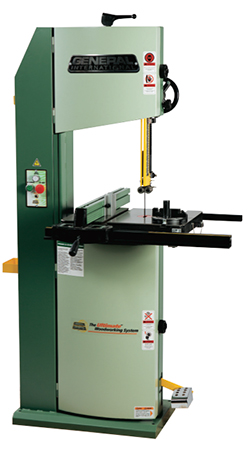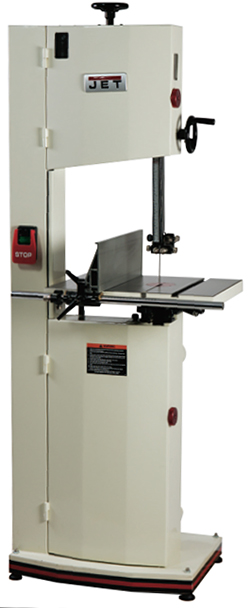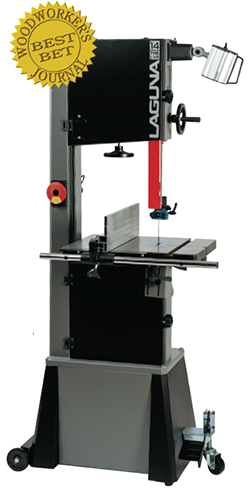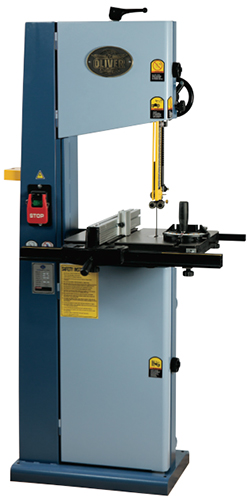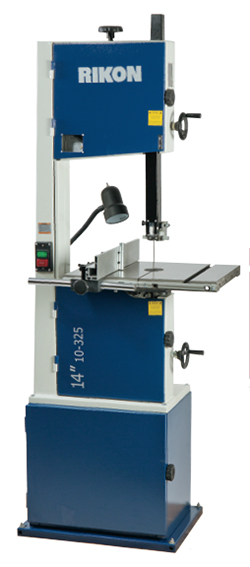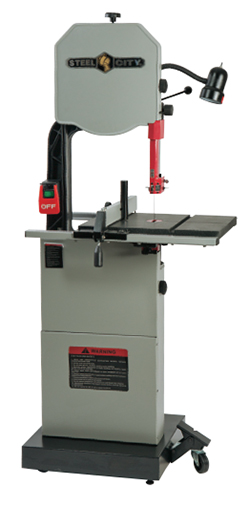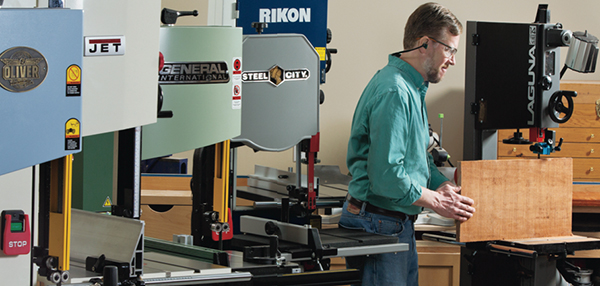
The benefit of steel-frame rigidity is now extending to many smaller band saws that run on 110 volts. How well do they work? We find out.
The downside to traditional 14″ band saws with all cast-iron frames is that many are limited to about 6″ of resawing capacity. Today’s “next generation” of steel-framed band saws solve the problem: their box-style spines are tremendously rigid to withstand the high tension required for a wide resawing blade, and their frames are extended for tall resawing. Lately, the category of 14″ steel-framed saws is growing. Even better, they’re equipped with 11⁄2″ to 13⁄4″hp motors that run on 110 volts! No need to rewire your shop for 220 in order to resaw the really wide stuff. But, is sub-2hp and household current really enough? I rounded up six different 14″ models and put them to work on 12″-wide hard maple to find out. And the results? Very pleasing! Here’s how they tested.
General International 90-170B
General International 90-170B
Street Price: $1,594.99
Motor Size: 11⁄2hp / 12.5 Amp
Table Size: 16″W x 20″D
Weight: 293 lbs.
Resaw Capacity / Throat Width: 12″ / 131⁄2″ Blade Length, Width Range: 112″, 1/8″ to 3/4″ Web/Phone: www.general.ca / 888-949-1161
General International’s 90-170B, along with all six of these test saws, did a fine job of general rip- and curve-cutting with a 1/4″ blade. But, a saw made for tall resawing as well as general cutting needs to satisfy three main criteria for me: the blade guides should be easy to adjust (since you’ll want to switch back and forth between wide resaw or narrow blades); the rip fence and features should aid in resawing; and the motor must be gutsy enough to keep the blade spinning through wide stock.
In most of these respects, the 90-170B has a lot to offer. It sports a generous, 16″ x 20″ cast-iron table, and a sturdy upper blade guide post moves smoothly up and down on rack-and-pinion gears to adjust its cutting height. The table sits on a pair of double- walled trunnions that enable it to tilt and lock securely, and when tipped, the table is
reinforced by an extra support arm and lock knob in back.
This saw comes with an Excalibur T-square style fence that, thanks to bearings, rolls smoothly on its front rail for ripping or resawing. A curved resaw attachment bolts on to provide workpiece “steering,” for coping with any blade drift issues during resawing. I wish the accessory were taller than 31⁄2″, though: for the maple resawing test, I wanted taller backup support, so I used a shop-made resaw jig instead.
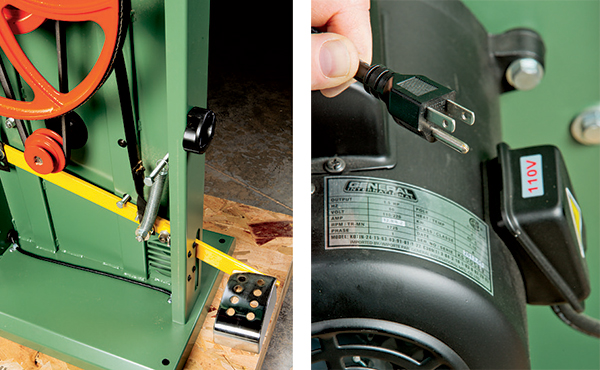
With the exception of Laguna, General and the other test saws come with ball-bearing upper and lower blade guides — a more heavy-duty solution than the “cool blocks” you’ll still find on some traditional 14″ band saws. Dual side bearings and a face-mounted thrust helped keep the 3/4″-wide resawing blade tracking straight on the 90-170B, and they adjust pretty easily too. The side bearings turn eccentrically with a screwdriver for fine adjustment, while either an Allen screw or a smallish thumbscrew locks them.
But, getting a wide blade into position in the first place is fussy work here. Blades load through a side slit on the table, then must be turned 90° in a small throatplate opening, while threading it in through a slit in the saw’s yellow upper blade guard and between the guide bearings. Once the blade is on the wheels, the lower left guide bearing is difficult to adjust without tipping the table up first. It’s all doable, of course, but it could be easier.
A cast-metal quick-release lever on top tensions the blade by twisting it down — and that will come in handy for de-tensioning between uses, too. Once powered up, this General’s 11⁄2hp motor helped it steam through hard maple, slicing six 24″-long veneer sheets with ease. Two 4″ dust ports in the bottom flywheel case kept dust to a minimum when connected to an 1,100 CFM dust collector. I also appreciate the foot brake that stops the cutting action in only about 1.2 seconds.
At nearly $1,600, this saw is amply featured, but it’s priced high relative to most of the test group. Blade-change fuss aside, it performed solidly.
JET JWBS-14SF
JET JWBS-14SF Street Price: $1,899.99
Motor Size: 13⁄4hp / 15 Amp
Table Size: 16″W x 211⁄2″D
Weight: 356 lbs.
Resaw Capacity / Throat Width: 131⁄2″ / 131⁄2″ Blade Length, Width Range: 125″, 1/8″ to 3/4″ Web/Phone: www.jettools.com / 800-274-6848
For a penny under $1,900 street, JET’s saw will be a shock to the pocketbook of most hobbyists. But that’s my only criticism of the JWBS-14SF. It was in all regards a pleasure to set up and use. Here’s why. Back to my initial criteria, JET has done its homework to make both upper and lower blade guides simple to adjust. Large knurled knobs control eccentrically moving double bearings on top, so they set without tools. The lower guide bearings are also easy to adjust: there’s ample room under the table for both hands, and even the rear rim- oriented thrust bearing has a control knob in front where you can grab it.
Blades thread straight in through a front slit in the table — easier than saws with side-slit styles — and a hinged upper guard opens for wide blade access. Once a blade is threaded, the saw has a three-position quick-release lever in back for tensioning. Viewing windows in the upper flywheel case, plus a large tensioning scale, help you keep track of blade settings at a glance with the door closed.
JET equips the 14SF with a phenomenal rip fence. The base casting is hefty and locks with a large ratchet lever, and
a beefy, 6″-tall extrusion provides plenty of backing for tall resawing or flips down to a second low position when cutting thin stock. The fence’s micro-adjust control is another helpful asset here.
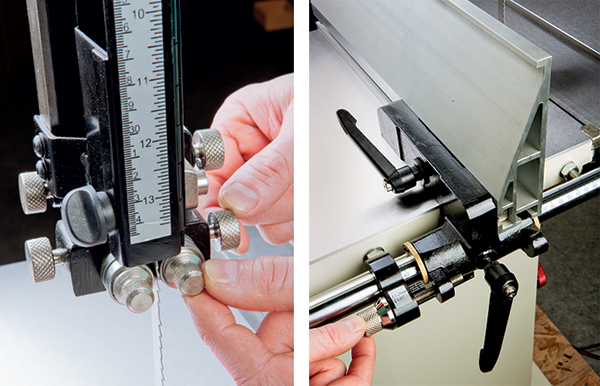
A large throatplate opening with milled aluminum insert, durable knurled door latches and oversized hand wheels are thoughtful, quality details. Even tilting the table is made easier, thanks to a geared crank lever and polished handle.
When I fired this machine up, I learned that it performs as well on the track as it sets up in the pit. There was plenty of power for resawing wide maple, while only about a tablespoon of dust was left inside the lower flywheel case afterward. Two long metal dust ports hook up to 4″ hoses for cleaner cutting.
While shelling out top dollar doesn’t always buy top quality,in this instance, I think JET’s JWBS-14SF will prove to be money very well spent.
Laguna 14-Twelve
Laguna 14-Twelve
Street Price: $1,097 w/o task light or mobility kit
Motor Size: 13⁄4hp / 14 Amp
Table Size: 16″W x 211⁄2″D
Weight: 258 lbs.
Resaw Capacity / Throat Width: 12″ / 135⁄8″
Blade Length, Width Range: 1143⁄4″-116″, 1/8″ to 3/4″ Web/Phone: www.lagunatools.com / 800-234-1976
Laguna has created an enticing package in this recently minted 14-Twelve band saw. Its 13⁄4hp motor and balanced, cast-iron flywheels drove the wide resawing blade through maple without bogging down under steady feed pressure. A single 4″ dust port in the bottom case kept dust to an absolute minimum. Heavy stock won’t shift the table off its tilt setting, either, thanks to two oversize trunnions that lend solid foundation below. This saw’s infrastructure seems made for heavy-duty cutting.
Laguna outfits the 14- Twelve with ceramic blade guides: four strips sandwich the blade at both guide locations, and two pucks provide rear support. Their aluminum housings slide along tracks in the guide mounting blocks for easier lateral adjustment, and plastic knobs lock them without tools. One gripe: the bottom blade guide area is cramped.
Despite its side-loading table, blades are still quite manageable to install, thanks to an oversized throatplate opening and a hinged top blade guard. A quick release flips up for blade tensioning, and you can check blade tracking and tension through
two viewing windows up top.
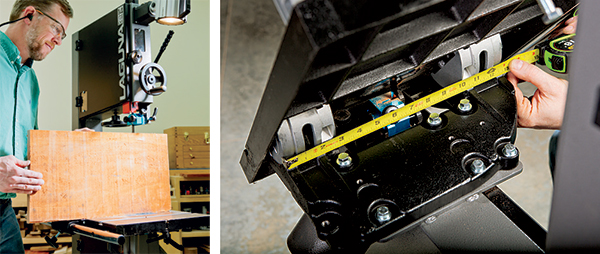
I like Laguna’s robust rip fence and the 51⁄2″-tall resaw facing for supporting wide boards. The fence can be adjusted for both parallelism and squareness if needed, although mine was spot-on from the factory. It has no micro-adjust provision like JET.
A “bare bones” 14-Twelve doesn’t include the halogen task light ($99) or wheel kit ($149) shown here, but they’re worth it. The light offers broad illumination of the cutting area, and Laguna provides a built-in receptacle to plug it in. That’s helpful! The three-wheel mobility system makes this saw pleasant to roll around.
All in all, the 14-Twelve is straightforward to set up, and it bests tough cutting jobs.
Oliver 4620
Oliver Machinery 4620
Street Price: $1,400
Motor Size: 11⁄2hp / 12 Amp
Table Size: 16″W x 20″D
Weight: 304 lbs.
Resaw Capacity / Throat Width: 13″ / 135⁄8″
Blade Length, Width Range: 1133⁄4″, 1/4″ to 1″ Web/Phone: www.olivermachinery.net / 800-559-5065
Side by side, it’s hard not to see some similarities between Oliver’s 4620 and General International’s machine: Their table systems, rip fences, blade guide components and tensioning provisions are virtually carbon copies, with the exception that Oliver outfits the upper guides with single, rather than double, bearings. Oliver’s frame is taller, too, by a couple of inches. This saw includes a full-size miter gauge, which is a convenient, useful feature. It has no foot brake. The slitted upper guard, small throatplate hole and side-loading table make blade changing finicky.
Given their common traits, I expected the 4620 to perform similar to General’s machine. But, when I pitted it against a chunk of 12″-wide maple, Oliver’s 11⁄2hp, 12-amp rated motor seemed to struggle to keep the blade spinning. I backed off to only gentle feed pressure, and I was able to slowly resaw six slices of veneer, but if I applied feed pressure consistent with the other saws’ resaw tests, the blade slowed to a stall again.
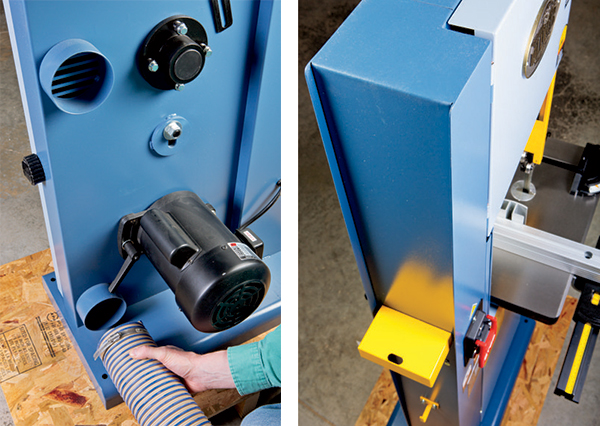
Consultation with Oliver’s technical department helped me diagnose the problem: one of the lower drive belts that tensions the flywheel pulley was overly loose from the factory. It’s not an adjustment you’d expect to make on a new saw, and it wasn’t inordinately loose, but adding more tension fixed the glitch. Powered back up, the saw was able to resaw at a feed rate consistent with the others, helping Oliver finish my cutting tests with a good showing here.
RIKON 10-325
RIKON 10-325 Street Price: $999.99
Motor Size: 11⁄2hp / 14 Amp
Table Size: 16″W x 201⁄2″D
Weight: 251 lbs.
Resaw Capacity / Throat Width: 13″ / 135⁄8″ Blade Length, Width Range: 111″, 1/8″ to 3/4″ Web/Phone: www.rikontools.com / 877-884-5167
Seven years ago, RIKON’s 10-325 won our “Best Bet” honors among a group of 14″, mostly cast-iron framed band saws. Now, after testing this tool again, I recall why. It’s sensibly designed, capable and easy to use.
Its guide bearings — single side and rim-mounted thrust — move with knurled knobs and tighten down easily with Allen screws. The lower guide bearings, hiding in table shadows on some machines, are easy to see and reach here. I love that the thrust- bearing knob is forward facing on this saw. No need to tip the table to adjust these guides.
Blade installation is easy, thanks to a front-slitted table and hinged blade guard. A left-right moving quick- release lever in back provides blade tension, and viewing windows in the top case help you see what you’re doing.
RIKON provides a fat spring for upper flywheel tensioning — a good provision for withstanding wide, stiff resaw blades. The 10-325 also has a sturdy rip fence with a fairly short fence beam and resaw bar. So, in the tall resawing test, I opted for a much taller shop-made resawing guide instead.
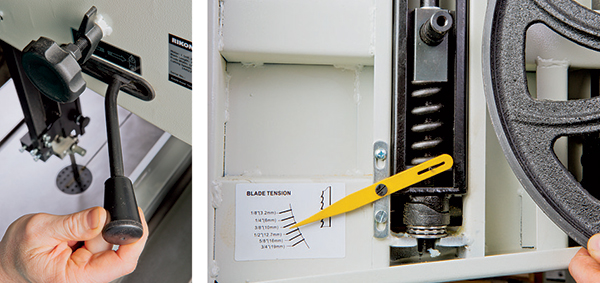
Other amenities include a geared lever for tilting the table, a spacious storage compartment and shelf below the saw and a flexible task light to brighten the table.
In testing, the saw’s 11⁄2hp RIKON-built motor muscled through hard maple, and most of the dust was whisked away through a lower 4″ dust port. For just shy of $1,000, RIKON continues to provide a solid value for the money here.
Steel City 50155G
Steel City 50155G Hybrid Street Price: $699.99
Motor Size: 11⁄2hp / 14 Amp
Table Size: 16″W x 21″D
Weight: 291 lbs.
Resaw Capacity / Throat Width: 12″ / 131⁄2″
Blade Length, Width Range: 105″, 1/8″ to 3/4″ Web/Phone: steelcitytoolworks.com / 877-724-8665
Steel City calls this saw a “Hybrid,” and that’s because, in truth, it’s an evolution of sorts: the frame is elongated cast-iron, with the bottom half nestled in a steel cabinet that opens for lower flywheel access. The design allows
the saw’s 11⁄2hp motor to be moved down to the rolling base for more stability. And, the wheels/caster are a helpful standard feature for moving this machine around.
Steel City has been off of our tool review “radar” for a number of years, so I was anxious to try this saw and see what it would have in store.
The 50155G’s webbed framework is designed for 12″ of resaw capacity. Blade guidance was assisted by double side bearings and face-oriented thrust bearings that can be adjusted with knurled knobs and thumbscrews. It’s a good, tool-free design. The bottom guides are tucked in close to the trunnion casting and table, where I found the left bearing’s adjuster hard to reach. But, at least the guides don’t require squeezing a wrench or screwdriver into that space while you’re at it.
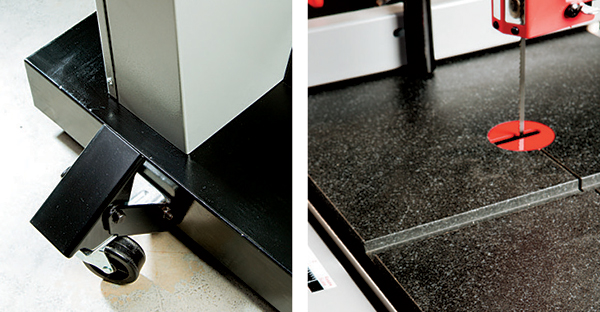
Steel City equips this Hybrid with a thick, granite table that’s dead flat and rust- proof. Blades load through a slit in its side and must be turned 90° at the throat opening. When installing wide resaw blades, you’ll also want to remove the two screw- mounted blade guards.
I like the saw’s 6″-tall steel resaw bar that mounts to the saw’s rip fence. I used the fence system with good success for the resawing test. And, after tensioning the wide blade with the machine’s quick-release lever, the 50155G chomped through wide maple in good stead.
A gooseneck light up top brightened the work area. The saw also comes with a circle-cutting attachment.
One concern about cutting: when visually following a pencil line, the red blade guard partially obscured my line-of-sight to the blade. A plastic window is there to peek through, but it created a distorted view of the line.
Dust collection through a 4″ port in the bottom kept this saw running clean throughout my cutting trials.
Coming in a tad under $700, Steel City’s Hybrid is quite long on features and easiest on the budget here.
“Best Bet” No Easy Pick
JET has a standout saw in the JWBS-14SF, but its pricing is steep. So, I think the “sweet spot” in this group centers on Laguna’s 14-Twelve and RIKON’s attractive 10-325. They ran a dead-even heat in terms of resawing capability, but my hat tips slightly in favor of Laguna. Its stout build quality testifies to Laguna’s long history of engineering industry-leading band saws. The tall fence, rugged trunnion assembly and pro quality blade guides are substantial and well designed. That said, RIKON’s 10-325 has real appeal: it is nicely equipped and an excellent, budget-conscious choice too.
